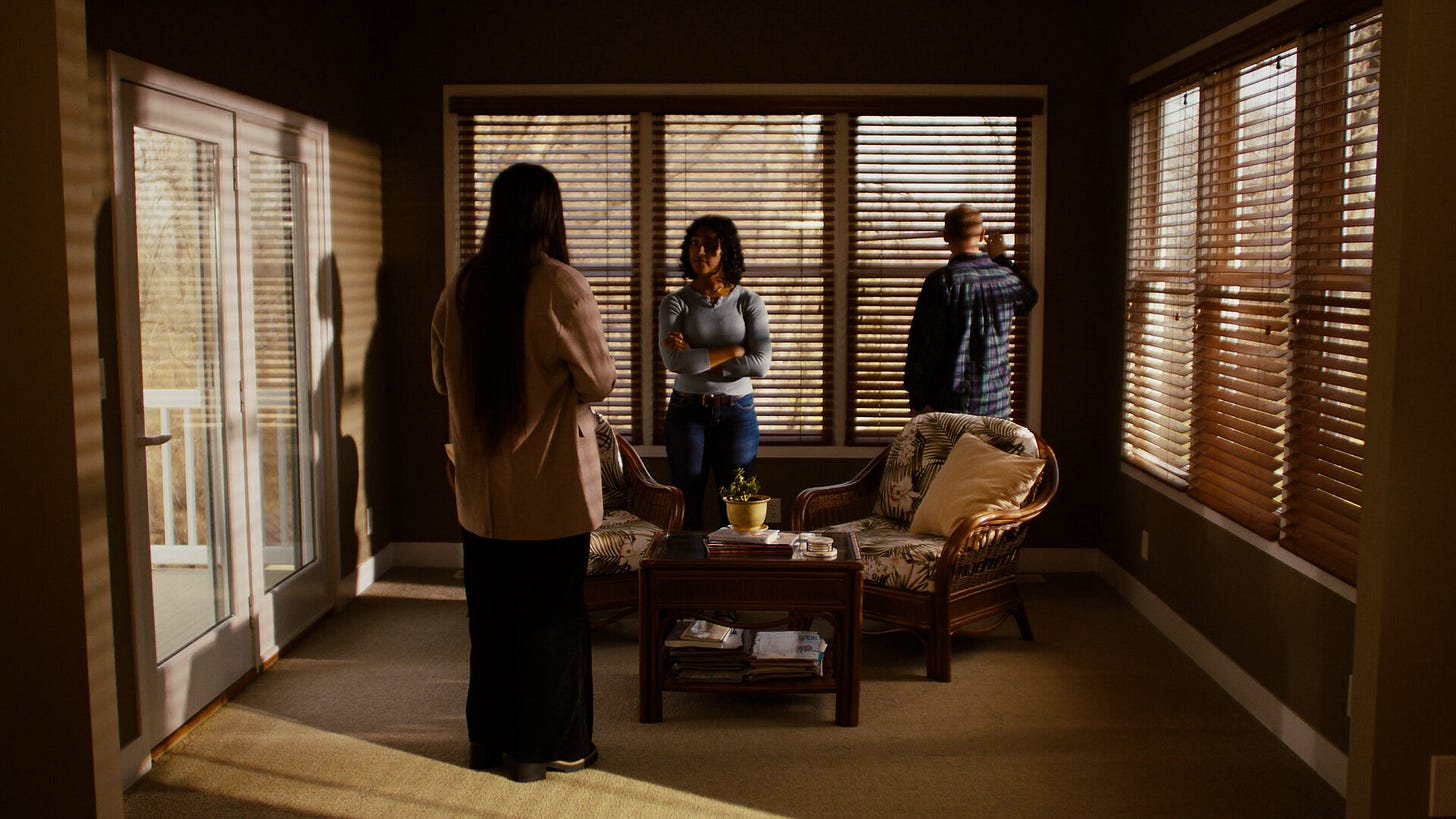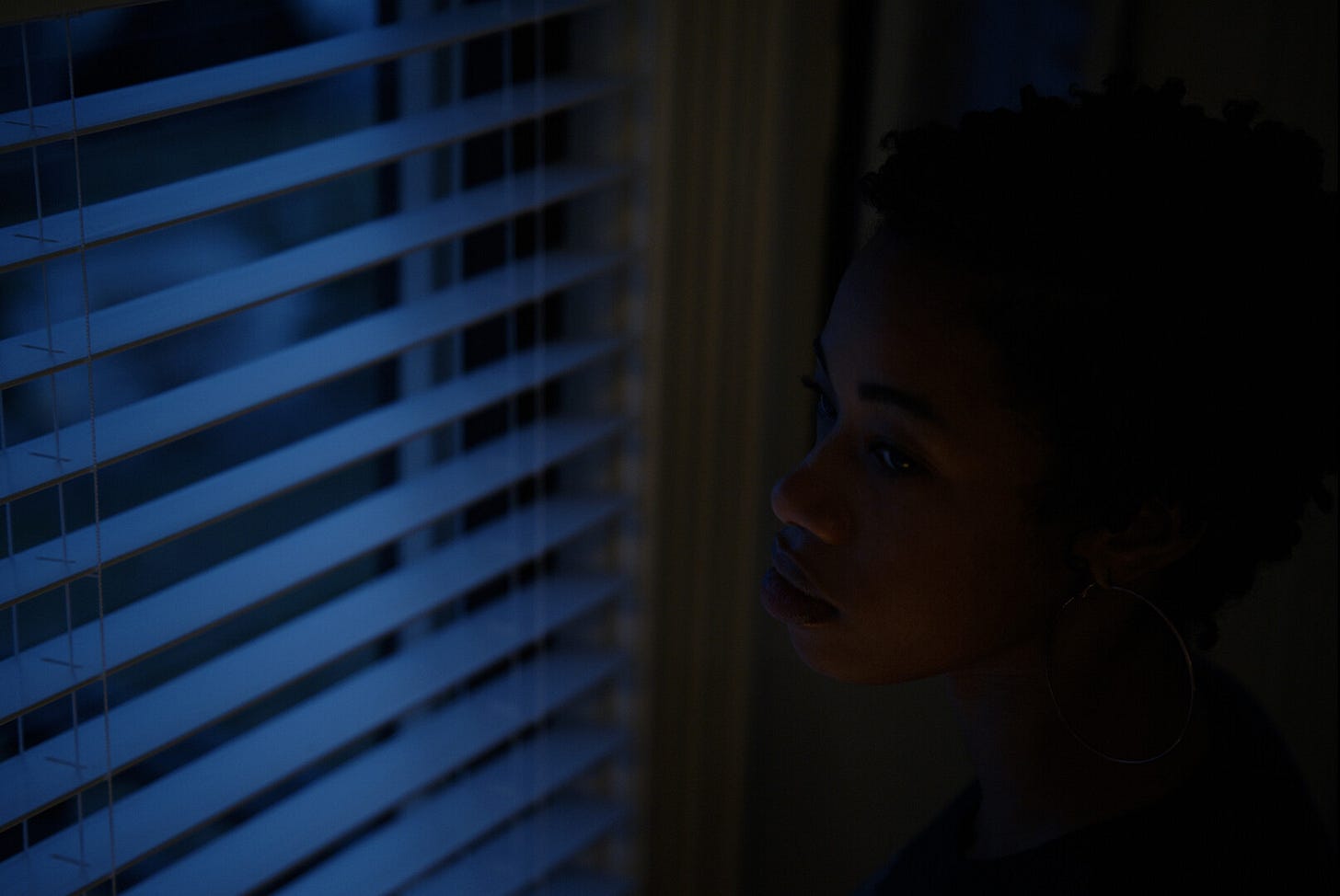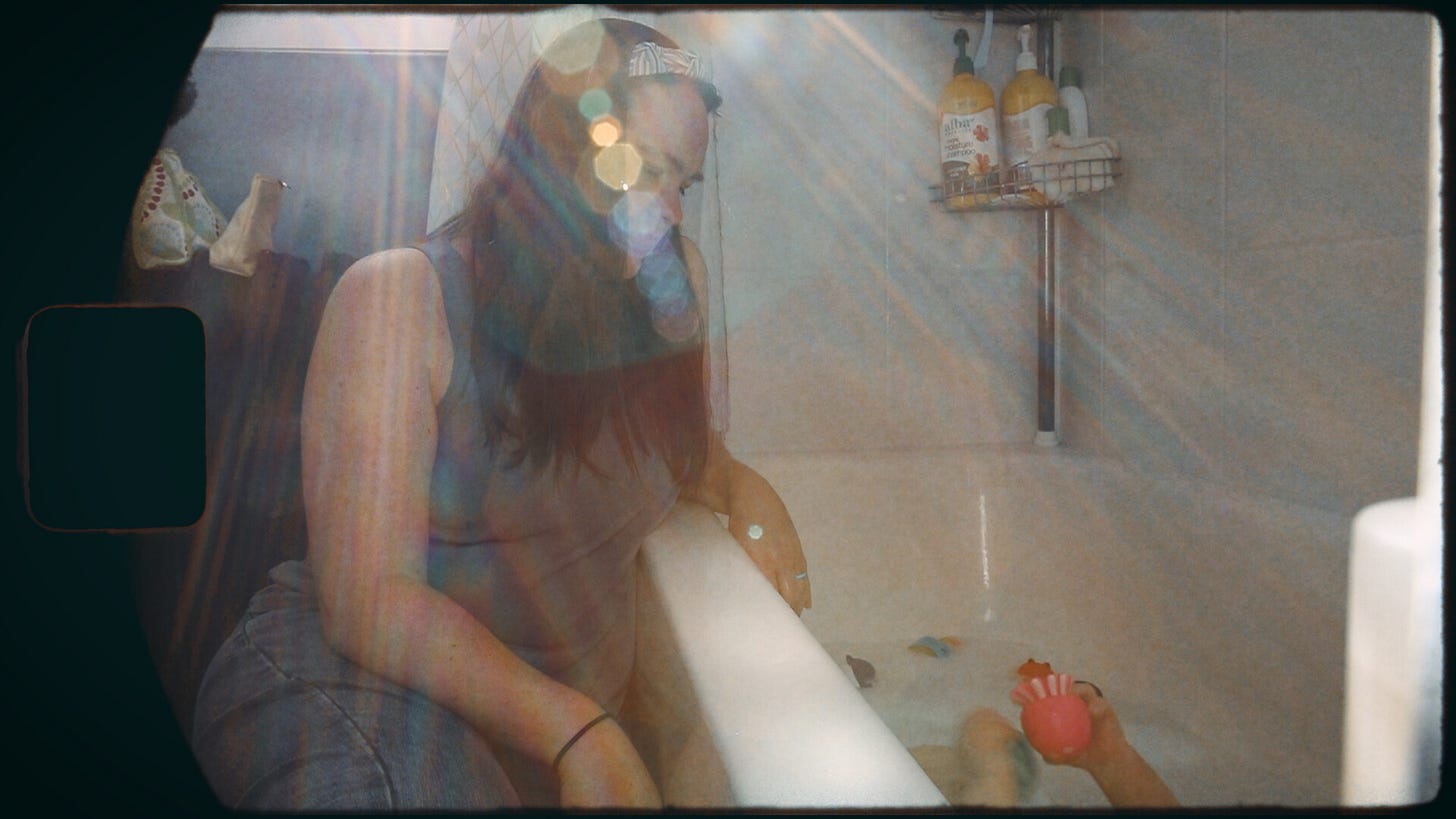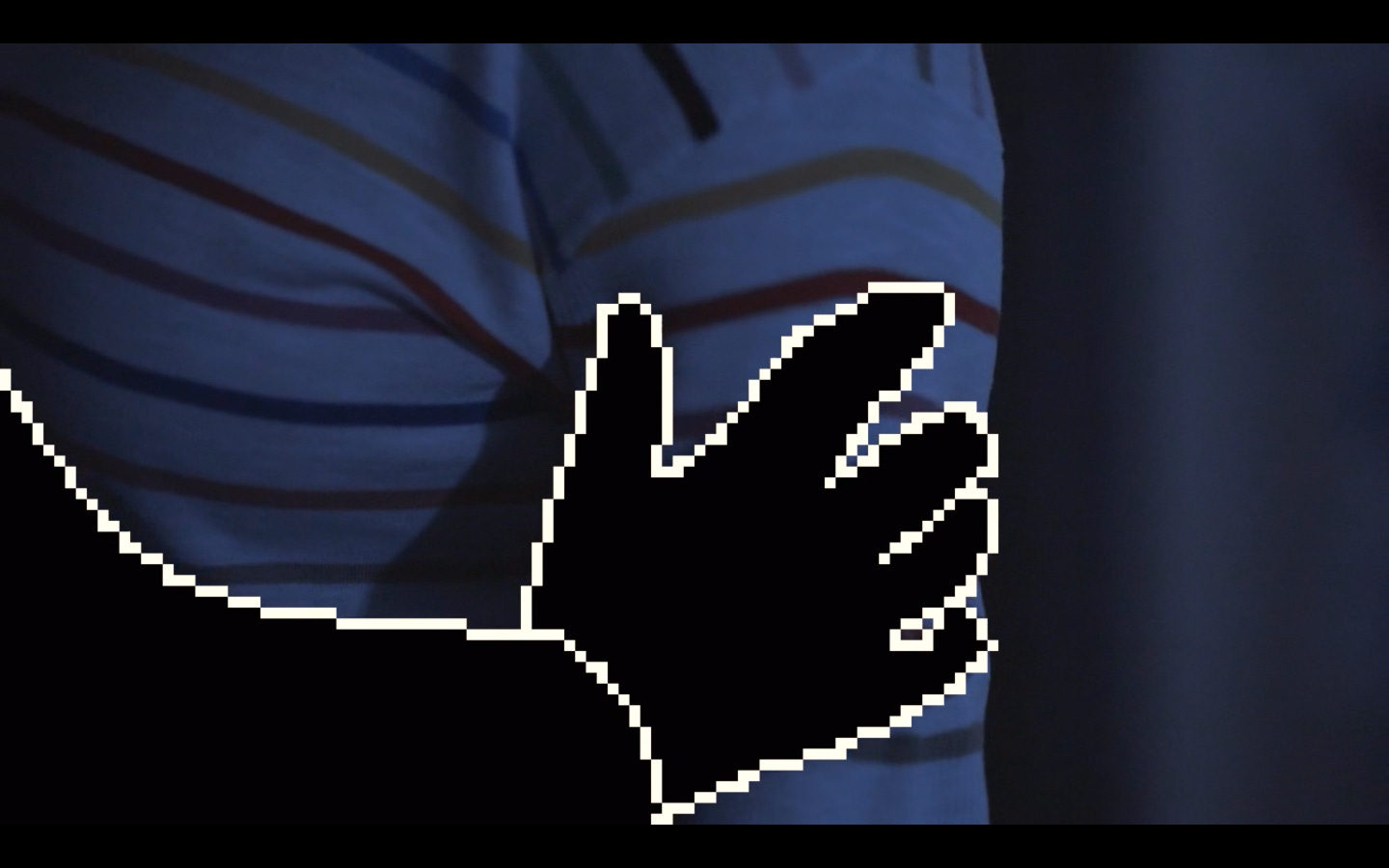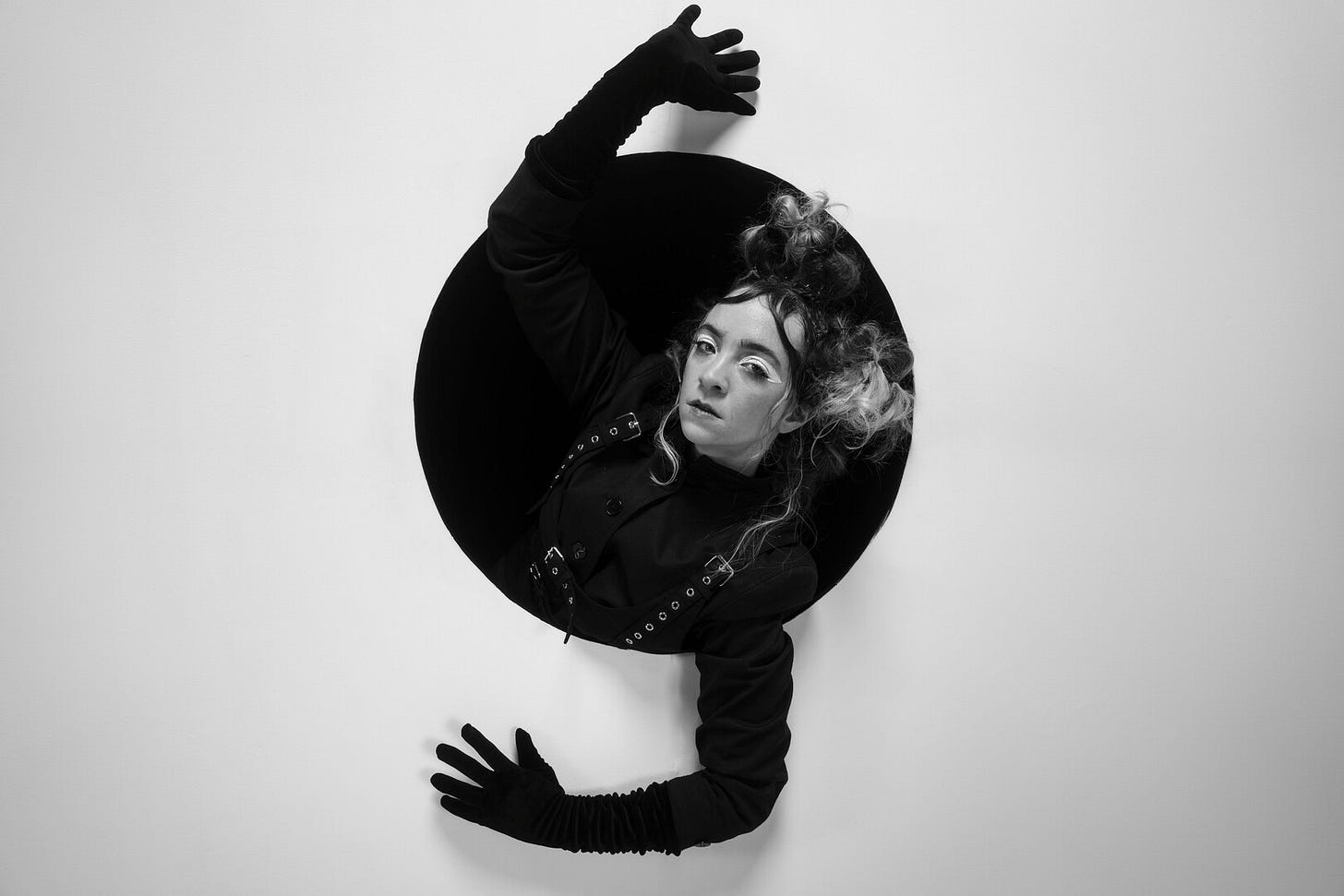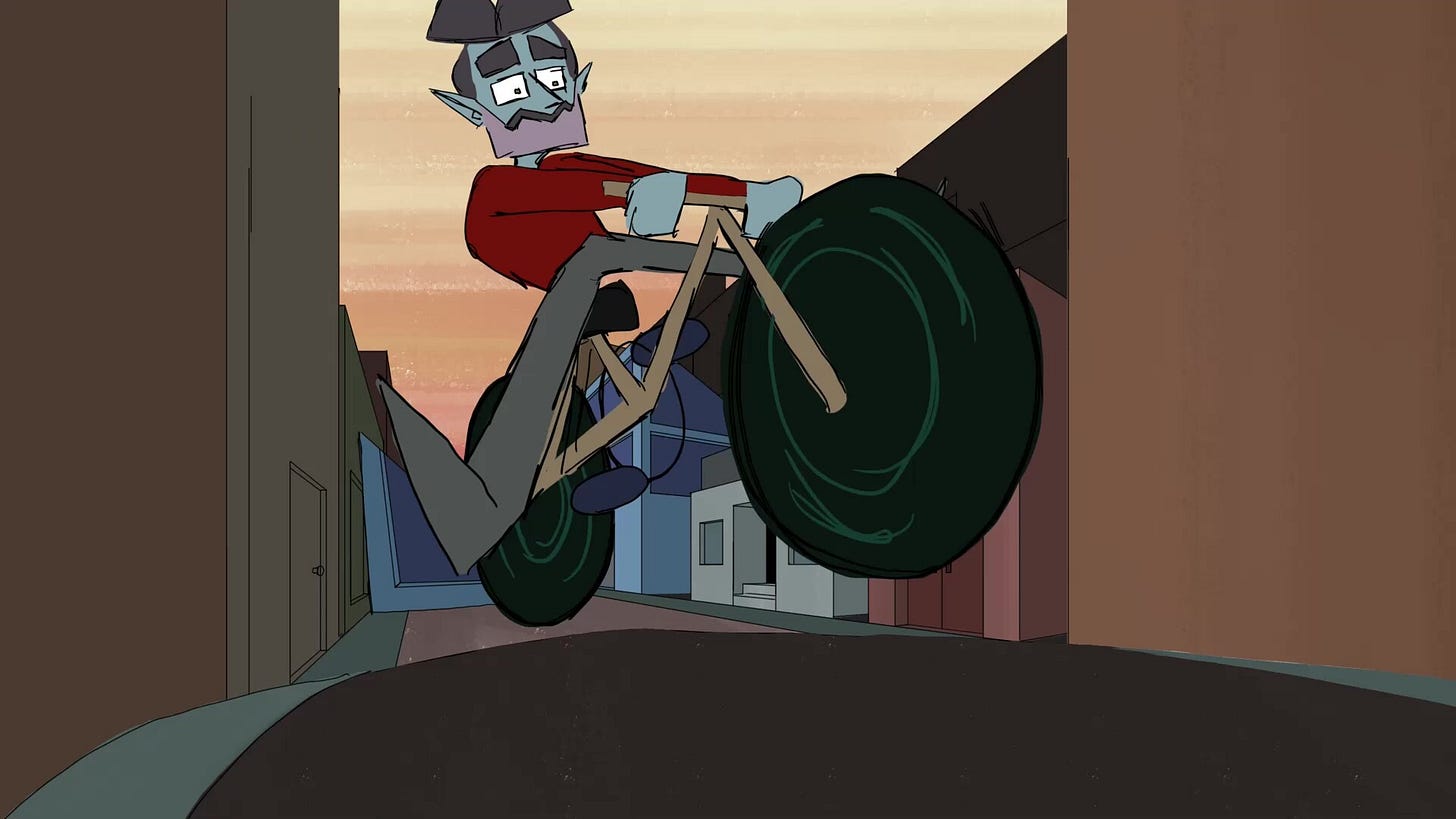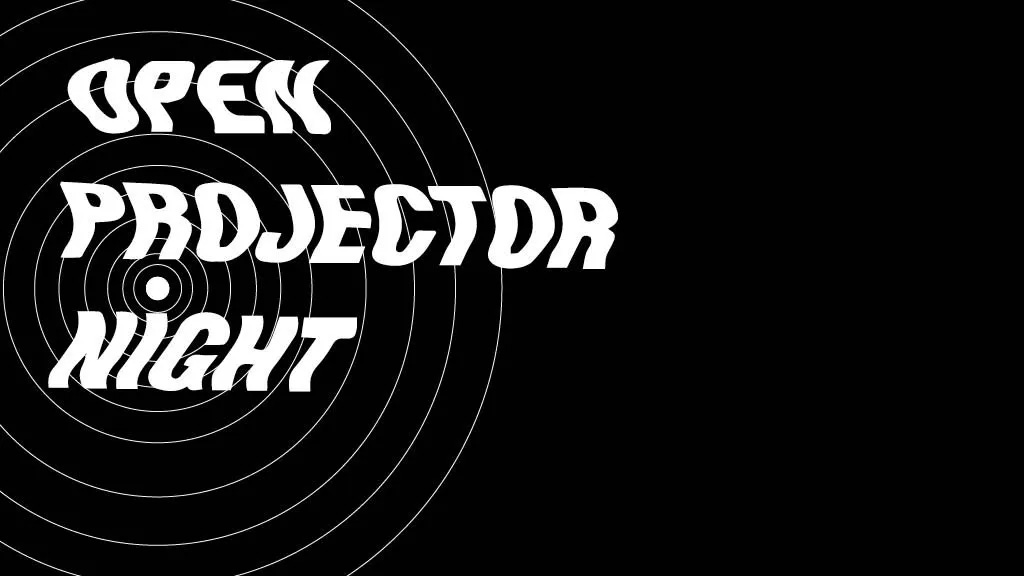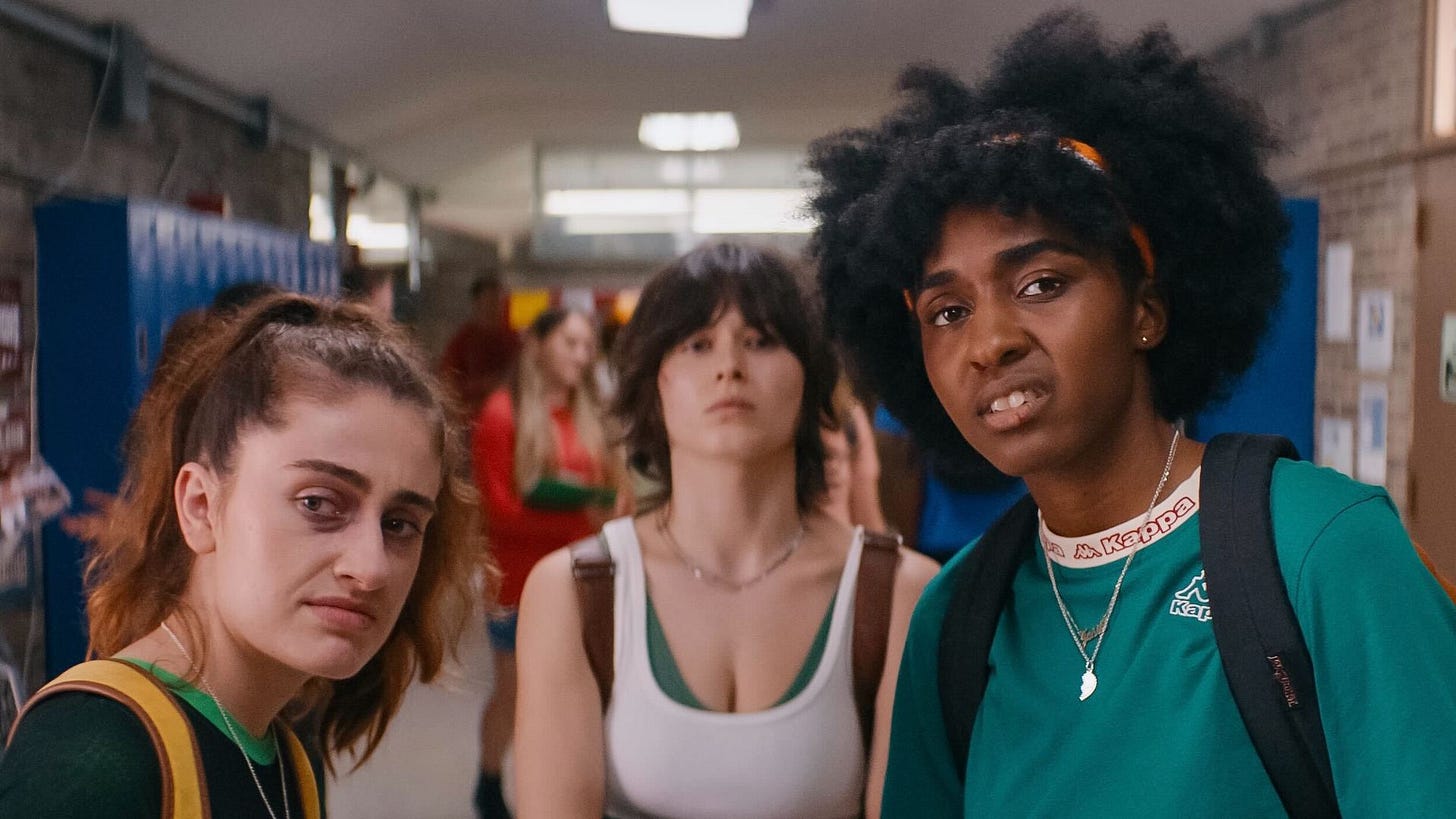[EDITED BY: SPENCER EVERHART & GRIFFIN SHERIDAN]
Welcome back to BEAM FROM THE BOOTH, the official newsletter of the GRAND RAPIDS FILM SOCIETY.
This WEDNESDAY (6/4) at 7pm, we’re thrilled to once again host OPEN PROJECTOR NIGHT, which highlights short films of all genres and mediums with a Michigan connection! Check out an extensive preview of the event below with interviews with each of the featured filmmakers.
And NEXT MONDAY (6/9), our MAN FROM ANOTHER PLACE: A DAVID LYNCH RETROSPECTIVE continues with another seminal work from the director: BLUE VELVET.
Now, check out our special preview of this week’s event below...
OPEN PROJECTOR NIGHT: JUNE 2025 PREVIEW
[BY: SPENCER EVERHART]
OPEN PROJECTOR NIGHT is a series we continue to be absolutely thrilled to present, and we’re back at it again! Please join us on the evening of WEDNESDAY, JUNE 4th, at 7:00pm to support and celebrate local independent filmmaking.
Our very own Spencer Everhart (who also helps in selecting works for the event) interviewed the selected filmmakers about their short films as a preview of this edition’s lineup for you all. Check it out...
The Open House (Sarah Kutchinski)
Prospective homeowners, Sam and David, are desperate to leave an open house after realizing they have already had an unfortunate run-in with the real estate agent, Kathleen.
Spencer Everhart: How did you originally get into cinema and what has your journey been as a filmmaker up until now?
Sarah Kutchinski: I have been a fan of storytelling all my life, but I was fortunate enough to take an Audio Visual class in high school that got me interested in filmmaking as a career. I continued to pursue filmmaking in college, and I now work full-time as a Producer and Editor. My ultimate goal is to be a writer and director, but I have enjoyed all my experiences as an AD, Art Assistant, AC, and as a grip to name a few. Outside of screening this film, I am in development for another coming-of-age short film I wrote — titled One, Two, Seven — and working on distribution for the pilot episode of Portraits of Poppy, a project I produced. There’s lots more to come, and I’m very excited for the future.
What was the primary inspiration behind your film? How did the project come about?
This project initially came about due to the 2025 CCFF Fortnight Film Contest. I was reached out to by Mimi Anagli, the DP, and Spencer Haydo, the gaffer, to write and direct as they were interested in being a part of the contest this year. As friends of mine and extremely talented filmmakers, I knew I loved collaborating with them and very much wanted to be a part of this project.
As for my primary inspirations, the story came from a combination of the movie Shiva Baby and the sitcom New Girl — specifically the characters Nick and Jess from that show. While some people may look away at these moments, I love seeing awkward and tense situations play out between characters, especially for comedic effect. Then the main conflict for the film became: if you were stuck in a room with someone, who are some of the last people you’d want to see and why?
What was the biggest challenge you faced while making this movie, and how did you overcome it?
Due to the nature of the Fortnight Film Contest, our greatest challenge was making the short film, from concept to completion, within two weeks. The quick turnaround required meticulous planning in pre-production so that we captured what we needed to during production and that the post-production schedule was airtight. We were able to overcome this obstacle thanks to the cast and crew's talents, experience, and hard work. I was lucky enough to be surrounded by people that are incredible at what they do, so the challenge ended up being not so much about whether we’d be able to complete a film within two weeks, but to push ourselves creatively and technically to make it as high quality of a film as possible; something I believe that we achieved.
What about this project are you most proud of?
Outside of the pride I feel in just completing a short film within a two-week span, I am most proud of how wonderful every stage of our project ran. We prepped as much as we could before production, our two days on set were fun, and everyone worked hard to get all that we needed — especially some difficult shots. Then the post-production team was amazing with the quick turnaround time. It felt like not only were we firing on all cylinders, but I take a lot of pride in how we all worked together as a team, something to me that is just as — if not more — important than the final result. I believe that a good film is intrinsically tied to the trust, dedication, and camaraderie of the cast and crew...so I feel proud of the experience we all had together, and I think it shows in the film we made.
“One Too Many Times” (Lauren Blackford)
Music video for the song “One Too Many Times” by Lauren Blackford.
Spencer Everhart: How did you originally get into cinema and what has your journey been as a filmmaker up until now?
Lauren Blackford: This was my debut! I’ve always been interested in film and music videos in particular. I grew up watching music videos on YouTube and always fantasized about writing and directing my own someday. Artists like Hayley Kiyoko and Billie Eilish were huge inspirations to me. Every time I wrote a new song, I usually came up with a video idea to match. So when it came time to release my music, it just seemed like the obvious thing to do. I had no idea how fulfilling it would be...I can honestly say there’s nothing else like it. I’m itching to make the next one, and the one after, etc, etc.
What was the primary inspiration behind your film? How did the project come about?
The initial ideas came right after I wrote the song. I would pace around my living room listening to the earliest demo on repeat, and certain music ‘cues’ would spark visuals in my head. I visualized specific shots, then full scenes, and eventually I was left with a narrative arc similar to my own experience. I wanted to tell the story of a short-lived relationship that leaves you reeling, with the added gut punch of knowing it’s happened before. I sort of sat with that video in the back of my head throughout college until I met Patrice Scott through a mutual friend of ours. Once he was on board to produce it, the storyboarding, casting, and other pre-production slowly came together. It was a slow-burn project, for sure, from start to finish.
What was the biggest challenge you faced while making this movie, and how did you overcome it?
The newness of it all. Being my debut video, every step from pre- to post-production was a new experience. I had some video editing experience, but from a directing standpoint, I was a baby. Thank God I had a clear vision for the video; it allowed me to be clear-headed and decisive despite being a rookie. I was also so lucky to work with such an incredible, knowledgeable, and forgiving crew. I was surprised at how much time and energy go into projects like these, but I feel much better prepared for next time.
What about this project are you most proud of?
The editing. Between busy schedules and travel distance, it took a long time to edit, but it was well worth it. The edit pulls a lot of weight in understanding the story and plot twist, so it would’ve been easy to mess up. The fast-paced second half required a lot of trial and error but turned out fantastic. I also love seeing people’s reactions when it switches to a new person for the first time, and the scene in the car when it switches between each love interest. So rewarding. Plus, seeing the results of these shots I dreamed up in my head felt like a dream.
Parallel (Kailey Barker)
Two artists living decades apart in the same apartment struggle with their creativity.
Spencer Everhart: How did you originally get into cinema and what has your journey been as a filmmaker up until now?
Kailey Barker: In high school I had to make a couple of filmed skits for a class. I loved writing them, I loved filming them, and I loved editing them. I had also always had a love for storytelling and the impact it has on others and myself. So naturally, when I came to Grand Valley I joined the student club GVTV. I quickly joined the film major where I continued to grow my passion and develop my skills. Now, as a recent graduate, I hope to keep making movies with my friends and tell stories like the ones that impacted me so much throughout my life.
What was the primary inspiration behind your film? How did the project come about?
I live in a historic apartment building that is about 100 years old (my film was also shot in this building!). The idea originated from me wondering what kind of people lived there before I did and what their lives were like. I had started writing this short three years ago, at a time when I had just moved out of my parents’ house for the first time and was struggling with a lot of self-doubt. Both of these situations ultimately found their way into the script. Over the years, I learned I was not the only person who felt this way. Many of my peers could relate, and I just kept coming back to this script. I knew it had to get made somehow so at least one person could feel less alone with this feeling.
What was the biggest challenge you faced while making this movie, and how did you overcome it?
The biggest challenge I faced during the production of this film was taking on multiple roles as writer, director, director of photography, and editor. It would have been extremely easy to become overwhelmed, especially because this was the largest crew/set I had been a part of at this point. I had to make sure I was on top of everything and that I was able to think fast. Although it was a challenge, I could feel myself improving in each of these aspects and am so happy I decided to take on this challenge.
What about this project are you most proud of?
I am most proud of how our 16mm footage turned out. I had only shot on film once before this, and that project was much shorter than this one. Shooting on film is like a whole new experience of filmmaking — where in digital you have a lot more freedom to keep rolling or do multiple takes for each shot. Film is much more restrictive and limited, so you have to be careful about how much of the roll you are using and how much is left. I am very proud of the crew and myself for adapting to this, covering everything we needed, and making it look great in the process. I fully believe the mix of digital and film in this short really added to it!
Paint (Angeline Irene Ameloot)
Two paintings in a museum argue about the visitors.
Spencer Everhart: How did you originally get into cinema and what has your journey been as a filmmaker up until now?
Angeline Irene Ameloot: I started making “movies” using the family iPad at about seven years old. I got into art and realized animation was the perfect combination of film media and visual arts.
What was the primary inspiration behind your film? How did the project come about?
The inspiration for my film comes from the Detroit Institute of the Arts and my friends. We communicate much of our love through jabs and irony.
What was the biggest challenge you faced while making this movie, and how did you overcome it?
The biggest challenge for my film would be having to deal with so many programs. Because I used both 2D and 3D techniques, I had to use both kinds of technologies and then blend them together.
What about this project are you most proud of?
I am most proud of the blending of art styles. Each character is animated in completely different ways, so making sure they felt connected was a big deal to me.
Stories Retold (Scott Berry)
A story about Love, Memory, and Loss.
Spencer Everhart: How did you originally get into cinema and what has your journey been as a filmmaker up until now?
Scott Berry: Set in my backyard of a small coastal town of NSW, Australia at the ripe old age fourteen is where it all started! A close friend of mine named Elliot had some acting skills, lots of time, and an old handy-cam. It was a recipe for creativity to be born! After countless retakes, numerous wardrobe failures, spending all our pocket money and using our friends as extras, we had made a masterpiece — or so we thought! Elliot and I showed the short film we produced to our family and friends, and we shortly realized we needed some more experience (a lot more) But thankfully the passion never left.
After not succeeding in making drama or comedies, a few years went by and I got into filming my friends surfing. At seventeen, I premiered my first surf film in my town’s cinema. When the credits rolled and applause filled the room of one hundred young surfers, I decided I was going to be a filmmaker for the rest of my life. Fast forward ten years, and I went off to film school in Hawaii!
I honed my craft and practiced primarily in short narrative documentary style videos. I did that for years. Recently, I have moved with my family to Northern Michigan from Australia and have been getting to know the creative community here. I’m currently a freelance filmmaker in Traverse City, Michigan and building a good client base and connections with other filmmakers!
What was the primary inspiration behind your film? How did the project come about?
The ultimate inspiration/motivation was to create an opportunity to build some quality friendships with local creatives.
What was the biggest challenge you faced while making this movie, and how did you overcome it?
It took a lot longer to shoot than first anticipated! With about a month between each shoot of a total of twelve, at the start I was pretty impatient. But I began to see it as a blessing because it meant I could throw everything I had into every shoot without compromising. For example we had time for rehearsals, good communication, family-style dinners, finding the perfect props/locations, and laughing at our mistakes.
What about this project are you most proud of?
I was blown away by everyone’s willingness to join me on the project! People offered their properties, homes, businesses, resources, props, energy, and time to make this film happen. It’s so encouraging for the future of filmmaking in Northern Michigan!
Invaluable (Faith Hutson)
Ms. Smith packs up to leave for the night after a long day of listening to her clients. She’s startled by a sudden knock at the door as she is not expecting anyone. Ms. Smith opens the door to reveal a very weary looking teenage girl. She quickly realizes that it’s her client, Jordan, who she has not seen or heard from in weeks.
Spencer Everhart: How did you originally get into cinema and what has your journey been as a filmmaker up until now?
Faith Hutson: I originally got into cinema through my family with writing. My siblings and I would take turns writing stories on a very old laptop, then we began to act out these stories. After a while, this extended to making parodies of our favorite movies. I fell in love with the process of character- and world-building, and so I began writing short scripts and turning them into skits...and this has been my journey as a filmmaker up until now; the scale of those small scripts got slightly bigger each time.
What was the primary inspiration behind your film? How did the project come about?
The primary inspiration behind my film was to somehow incorporate a celebration of Black queerness as it’s something I have struggled with my entire life up until now. I think the outcome of this project did exactly that, and I couldn’t be prouder of what I created.
What was the biggest challenge you faced while making this movie, and how did you overcome it?
The biggest problem I faced making this movie was dealing with the issue of weather. Most scenes were written to be shot in sunlight, but on production days it rained heavily. To overcome this issue, I wrote two alternative scripts to still capture what I was going for even with those constraints.
What about this project are you most proud of?
I’m most proud of this project because it’s a deep reflection of not just me but the WLW queer community. It highlights how queerness can, in fact, heal you in ways you’ve never imagined. This film illustrated how queer love is capable of transcending time itself.
Reincarnate (Tabitha Blanski)
A short documentary about a woman who loses her mother to cancer weeks before giving birth to her first child.
Spencer Everhart: How did you originally get into cinema and what has your journey been as a filmmaker up until now?
Tabitha Blanski: It's probably my parents’ fault. As a kid, my dad was always watching something weird on TV and my mom was always reading a book. I learned that stories were this beautiful way of seeing the world and thinking about what it means to be human. While I still love a good TV show or a good book, film was unique both in its self-contained-ness and its ability to harness sound. When I was eleven or twelve, my parents showed me Mission: Impossible, and I immediately went to Sam Goody and bought the soundtrack. When Titanic came out, my friends and I would listen to James Horner's score and cry over our favorite scenes.
Eventually, I saw Christopher Nolan’s Memento and realized that films could also be mind-blowing puzzles. Filmmaking appeared to be the most fun job in the world, and that's what I wanted. I graduated with a film studies degree from Calvin University and spent my last semester in Los Angeles. That's where I learned filmmaking is also a business and filmmakers actually have the mostly-impossible job of balancing their creative, wild dreams with money. That did not sound like the most fun job.
I returned to Michigan, got married, and had some kids. For a brief time, I worked on a handful of small documentaries and then got into photography. I started my own photography and video studio, Inkling Pictures, doing mostly wedding work and continued to dream about what kinds of things I might like to make on a small budget during my precious quiet hours. In 2019, I started filming my first documentary, and I've been having the most fun and difficult time of my life.
What was the primary inspiration behind your film? How did the project come about?
Reincarnate grew out of a desire to put together something with the terabytes of footage I had collected over five years for my still-developing, feature-length documentary film. There is a wonderful music licensing service, Musicbed, that hosts a yearly filmmaking contest, and I'd always wanted to submit. The contest gave me some project parameters and a deadline. It also gave me a chance to take a deeper look at the subject of my film who was the least compelling. I narrowed in on Anna’s story and tried to figure out what she had learned over the year-and-a-half that I followed her.
What was the biggest challenge you faced while making this movie, and how did you overcome it?
I think the biggest challenge was myself and my expectations over what made this film “good” or “bad.” When Reincarnate wasn't selected for the Musicbed competition, I had every intention of hiding the piece away forever even though I still felt proud of what I had created and of how it had come to shape my thoughts on my subject.
When I did decide to start submitting the short to other festivals, I had to re-do all of the music because I couldn't use the Musicbed pieces any longer unless I wanted to spend hundreds of dollars. My vision needed to adjust based on what was available to me. That was frustrating, but I'm really pleased with how the constraint forced me to think outside of the box. I got to use my choir's rendition of Allegri's Miserere during the spreading of the ashes and Anna's eulogy. I wouldn't have tried that otherwise.
What about this project are you most proud of?
I'm really proud that I finished something that is meaningful to me. I'm really proud that I discovered Anna's story through the making of this film. And I'm proud that the film has a chance to be seen by an audience.
In Dreams... (Nevin Hooper)
After a mysterious accident, a woman searches a dreamscape for her sister.
Spencer Everhart: How did you originally get into cinema and what has your journey been as a filmmaker up until now?
Nevin Hooper: I first got into movies when I saw the original Star Wars film for the first time. I was pretty young, and I still vividly remember watching it and in the very beginning when Darth Vader first steps through the smoke from the doorway — it just blew my mind. I knew I wanted to recreate this feeling from that moment on. So ever since, movies have always been my thing. From there I had made a couple little things, but it wasn't really until I got into high school with an AV class that really pushed me to understand more about the filmmaking process. And after that it was just keep doing it and finding like-minded people to make cool stuff with.
What was the primary inspiration behind your film? How did the project come about?
The very first inklings of the idea came from an episode of Neon Genesis Evangelion where the main character is angry and alone and there is this flash of an animation that goes across his face to represent his emotional state. It's a super fast moment, but it really stuck out to me, and I really wanted to create a similar effect in live action. After that, it was coming up with a narrative to fit this experimental style, and I have always found dreams very fascinating...so that was the jumping off point. Once I got the story slightly figured out, it turned into a very David Lynch-inspired dreamscape mood piece.
What was the biggest challenge you faced while making this movie, and how did you overcome it?
Probably the biggest challenge when filming was the dream sequences since we only had a few hours to shoot in this parking garage; it was night, and we were in a concrete area in the middle of February, so it was incredibly cold. It was definitely a test of endurance for me and the entire crew. A fun fact about that was the second dream sequence we intended to shoot in the garage as well, but we couldn't get the shot we wanted because of a bunch of circumstances out of our control, and we ran out of time...so we had to pack up and leave with an entire scene up in the air. Thankfully, through the guidance and input of the rest of the crew, we were able to get done early enough to reshoot that entire scene out in the street from the location that we were shooting the bedroom scene at. So it weirdly worked out because my original thought for the scene was having it in a separate location, but we didn't think we had the time and budget for a whole other company move. But the circumstances forced us to anyway, so that was an interesting turn of events that I think really paid off.
What about this project are you most proud of?
The thing that I am most proud of with this project is that from conception to finished product, this was exactly the film I had intended to make. The story changed a lot, but the overall feel and vibe I was picturing when I had that first inkling stayed consistent, and I am incredibly happy about that. It was honestly thanks to the entire cast and crew as well, working with all of those insanely smart and creative people made this such a rewarding experience for me. It's a film that very much aligns with my interests in filmmaking, so I am really proud of the result and the people that I worked with to make that all happen.
“Through the Mirror” (Jeremiah Bulkowski & Spencer Brown)
Music video for the artist Crystal Trench. Crystal Trench enters into a fantasy world where they face rebirth, transformation, and self reflection.
Spencer Everhart: How did you originally get into cinema and what has your journey been as a filmmaker up until now?
Jeremiah Bulkowski: My initial interest in film stems back to a short summer program run by the CMC! It was in high school, and I believe the person running our program was Gretchen who was very encouraging to people kind of just getting their feet wet for the first time with a camcorder and editing software. Eventually. I jumped into the film program at GVSU and since then have been freelancing in the camera department on commercials, music videos, and feature films in Chicago.
Spencer Brown: I’ve made short promos for my friends’ music releases in the past; including one for Seth Beck and one for the band Edlear. Nothing of this caliber, though. This is my first larger film project, and I’m happy how it turned out, and I’m grateful to have played a role in this project with so many dear friends. We made something really cool together.
What was the primary inspiration behind your film? How did the project come about?
Bulkowski: Vanessa (Crystal Trench) was in Chicago one week recording with our friends at Rat Future studios for the EP, and since Rat Future are neighbors of ours, we went to say hi and ended up getting to listen to the entire thing in their mixing booth. The vocals and dark electro synths immediately drew me in, and we started just talking about music video ideas in their studio as we listened to each track. They were mostly random images and blurbs, but substantial enough for us to be asked if we wanted to try one. We pitched an idea for “Through the Mirror” kind of with three themes as our concept: reflection, descent, and liminal space. The song kind of leant itself to a darker world we envisioned, and Spencer and I were both called to a black-and-white aesthetic for it.
Brown: The primary inspiration for the music video was the song. It conjured gothic visuals for Jeremiah and I when we were hashing out ideas. The themes of transformation through the internal realm within the lyrics guided us to create the three scenes and have Vanessa move through these as they do in the song.
The project came about when Jeremiah and I were at Rat Future, a recording studio I’m a part of, and listening to Vanessa’s mixed tracks and Jeremiah asked Ness if they’d be open to having us make them a music video and they said yes! Jeremiah and I then brainstormed ideas inspired from “Through the Mirror” and we narrowed it down into what you see today.
What was the biggest challenge you faced while making this movie, and how did you overcome it?
Bulkowski: One of the biggest hurdles we had to overcome involved some production design elements, especially the silver obelisk in the beginning of the video. We knew it was important to the concept, but none of us are really carpenters or have experience fabricating something to that scale. After many iterations on paper, we did some tests with different materials and just had to experiment with what would work on camera and what was practical. It was actually completed on the day we had to shoot it, but once it was standing on its own and picture-ready, we were able to get some really great shots with it — some on our shotlist and some not — and that’s when I knew the rest of the shoot was going to be great.
Brown: The biggest challenge was time. We shot this in three days, and we could have used four — so it goes. We over-planned and shifted quickly when needed. Additionally we had an awesome AD, Meghan Shannon, she kept us on track and made sure everyone was being cared for on set.
What about this project are you most proud of?
Bulkowski: I’m most proud of the overall story element of transformation on the screen. From the changing set design and the VFX elements that lead us through them, it really feels like the story we went out to shoot really came alive. Lauren’s amazing styling work for this really took that to the next level. The art production without a dedicated production designer turned out great too. At some point, everyone was hammering and drilling and cutting something different each morning. It’s also very rewarding to be able to create art with great friends who without them this couldn’t have been accomplished. Thank you a million times.
Brown: This is a hard question to answer because I’m so proud of this whole piece, and of everyone who played a role in making this happen. Shout out to Vanessa DeCouto (Crystal Trench) for trusting us with the shoot and working with us to make it happen, Jeremiah for being a the best co-director/DP in the land, Josue for being the best gaffer in the midwest, Lauren for absolutely slaying the styling, Alex for all his help with set building, and everyone else on the shoot — it really couldn’t have happened without all of you. You’re amazing.
I am most proud of the visual narrative Jeremiah and I wrote. I think it serves the song in that it captures what the song is saying without being literal. I’m a fan of surrealism and dream-states, and I’m glad these qualities shined through in the end piece.
An honorable mention: the obelisk you see at the beginning of the music video was a beast to build. We went through a lot of design changes with that set piece and ended up with what you see in the music video. I’m also proud of this piece of the project.
VIOLATOR (MacLain Bowman)
A man tries to survive by the skin of his teeth as he's pursued by a vicious bounty hunter.
Spencer Everhart: How did you originally get into cinema and what has your journey been as a filmmaker up until now?
MacLain Bowman: The main thing that got me into doing animation/film myself stemmed not from any big studios like Disney, but rather seeing all the great animation online posted on sites like YouTube that were being produced by independent animators. Witnessing all these great works being brought to life by these smaller creators as a young kid made me realize that participating in the art of animation wasn’t something exclusive to massive studios on the west coast or overseas and that great animation can come from anywhere and from anyone. At the beginning of my animation pursuits, I was really into creating 3D animations for the first few years, but overtime I began to take a liking to creating 2D hand-drawn animations more and more until it ultimately became my preferred animation medium of choice. Even though I may not do as much with 3D animation these days, the skills that I acquired when I used to create 3D animations as my primary focus still play a large part in how I go about creating my 2D hand-drawn animations today, and they are made all the better for it.
What was the primary inspiration behind your film? How did the project come about?
Coming off from working on an animated project that consisted of a ton of wordy dialogue and a relatively grounded premise, I wanted to create an animated short that was pretty much the polar opposite of that with no dialogue and over-the-top action. Animating dialogue was a very labor-intensive process when I was creating that previous animated project, and that more grounded premise didn’t leave as much room as I’d like for experimentation — so to not have to worry about both of those things at all when creating what would become VIOLATOR was very liberating and gave me the chance to be more loose and have more fun with how I approached creating it. That desire for a more loose way of developing VIOLATOR also played a key role in determining things such as its rough-looking art style and the pretty straightforward narrative. I also tried to keep to a self-imposed deadline by attempting to complete the film in the span of a few months, and while I blew a bit past that self-imposed deadline a couple of times, it did help with keeping me on track while I was creating VIOLATOR.
What was the biggest challenge you faced while making this movie, and how did you overcome it?
The one thing that was especially tricky to nail down more than any other part of making VIOLATOR was, to my surprise, creating the backgrounds. Animating shots like the ones involving the bike also had their challenges too and took a lot of time to make, but the backgrounds went through the most amount of iterations by far. It was just surprisingly difficult to get them looking right even though they’re far from the most impressive looking backgrounds in the world. I’m sure part of it had to do with my lack of experience with drawing backgrounds up till the point when I had to create them all for VIOLATOR, but regardless they proved to be quite the challenge for me.
What about this project are you most proud of?
I’d say I’m pretty happy with the overall pacing and flow of VIOLATOR more than anything else. I’ve always felt like with my previous works that the pacing was always something where they fell especially short, so for this project to have turned out as solid as it did in that regard was a real feel-good moment for me.
Volador (Miguel Angel Hernandez & Tessa Elizabeth Osborne)
Mateo, an 18 year-old from Mexico, fights his way through challenges that arise in a place, Grand Rapids, he would describe as dull. He works as a part-time cashier and commercial photographer for Supermercado Mexico. While living in a house that's constantly throwing parties, he feels lost and is tempted to leave his dreams for America behind by retreating back to Morelia, Mexico. With the help of his friends Aliyah and Dbo he finds a new perspective.
Spencer Everhart: How did you originally get into cinema and what has your journey been as a filmmaker up until now?
Miguel Angel Hernandez: I’ve always felt a deep, unconscious connection with filmmaking, whether through creating videos or being influenced by the movies I watched. I remember when I lived in Mexico, picking up a video camera for the first time when I was seven years old just having fun with my little brother and friends, creating stories around our old neighborhood. Those early experiences were my first taste of filmmaking.
However, my real awakening to the power of this medium came during the pandemic. It was a time of collective change, and I wanted to explore how we adapt to and are affected by such shifts. I created a music video titled ADAPT, documenting these universal feelings. This project marked my debut as a filmmaker.
Following that, I returned to my birthplace — Grand Rapids, Michigan — to pursue my dream of making films. Despite the language barrier and initially knowing very few people, I gradually made connections that allowed me to do what I love most: making cool films with cool people.
Tessa Elizabeth Osborne: When I was a kid I would always beg my dad to let me use the camera we had in the house which actually shot right onto a little tape. We could plug it into the TV and watch the clips we shot. It was pretty cool to me, but it wasn't until we got a little point-and-shoot camera that I was able to shoot and edit little films I would make with my sister called “Magical Sisters.” Even if it was silly, I learned a lot about how to make edits that could create illusions which I really loved to do. When I was in high school, the political climate started to change for the 2016 election. I was growing up in unprecedented times where we had the #metoo movement and #blacklivesmatter. People were more vocal than ever, and I wanted to do my part to change things...even if I wasn't sure what that was yet. It wasn't until college that I started to get back into filmmaking again. During that time I was making an investigative documentary about my rowing coach from high school. The story followed kids whose lives were deeply impacted by the actions of this coach and the school's negligence, and I wanted to raise awareness through the power of storytelling. Everything I shot at that time was done on a little point-and-shoot Canon camera I bought for $50. I even edited everything on a software I found on Microsoft’s app store. That project taught me that storytelling could be my way to create advocacy and change, which is why I went into Documentary Production and Journalism at Michigan State University. After I graduated, I began working as a photojournalist for News 10 in Lansing while working with Miguel in making Volador. Just recently I was able to change positions where I now work as a producer/photographer for our sales team where I am able to make commercials while still working for Rice Pictures where I make media that uplifts women and people of color's stories.
What was the primary inspiration behind your film? How did the project come about?
Hernandez: Volador was mainly made as a love letter to this new life of mine and all the people who made Grand Rapids feel like a new home. I wanted to make a film as an appreciation for everyone who once interacted with me and allowed me to see this place with a welcoming perspective. Something that, to this day, I’m very thankful for.
There were not many short films out there about the immigrant experience that allowed themselves to be real but also funny and relatable at the same time. This and many other factors inspired me to do this collective piece, and they continue to inspire me to this day.
Moving to Grand Rapids was tough. It felt nothing like home. But no matter what, I kept creating. I focused on projects that excited me, and after a year, I found people who shared the same love for creating. That's when Tessa and I met. We both found ourselves at the exact moment of wanting to express our perspectives. That not only helped push each other as individuals but also allowed the making of Volador to become a successful experience for us and everyone involved.
Thanks to my cousin Rico Padilla, who I continue living with, and who was involved from the scriptwriting to the post-production of the short. He invested so much of his energy into this meaningful vision from letting us borrow his house for a whole week to even getting a tattoo of the short film itself. He can be wild sometimes. Omar Arredondo, our main producer, with all his excitement, love, and support for everything Volador and our culture means, allowed this short film to come to existence. I could keep talking about all the cast, crew, and people who supported us forever, but I just want to say that without them, we wouldn’t be anyone. Thanks to them, this short film is alive.
Osborne: The primary inspiration for the film was based on whatever was inside Miguel’s head at the time! In all seriousness though, the story follows some things he has personally gone through, but I was able to help him create a more fictional version to help with storytelling. Some of the changes I made were inspired by my goal to create representation in film. I wanted to have a strong female character who was a good voice of clarity for Mateo. She is gentle but assertive enough to really get into Mateo’s mind. These are qualities I learned from my mother who I consider a strong woman in my life. I wanted these characteristics to challenge the more common themes of ‘the gentle woman’ so that, again, we can create a more diverse palette of people in film that better reflects everyone. I was also very inspired by events that happened in my own life of people I knew who gave up on their creative dreams to pay the bills. I wanted to highlight that discussion to remind them, and even myself, not to give up on something we've been so passionate to do just because it's tough now.
What was the biggest challenge you faced while making this movie, and how did you overcome it?
Hernandez: Letting go of my ego. Co-directing with Tessa taught me how to listen...really listen. I had to learn that being personally attached to every idea wasn’t helping the project grow. Filmmaking is a conversation, not a monologue. And when you invite someone else into the vision, you have to make space for something new to emerge. That was tough, but it changed me — in the best way.
Osborne: Oh gosh, the biggest challenge was...everything? Making an indie film for the first time is not for the weak. I have grey hairs I am still plucking out from that set. We had to change our DP a week before set, find a new sound guy three days before set, we had five days to shoot and two of them ended up pouring down on us. It was challenging, and without a good crew who was down for the challenge I'm not sure we would have made it out the way we did. I really think we were able to skid through with the help of friends; huge thank you to Omar Arredondo, Najd Ayari, and Enrique Padilla for always having a solution to whatever problem came up.
What about this project are you most proud of?
Hernandez: Soooo many things. Even a year after its release, I’m still overwhelmed with joy. What makes me happiest is seeing how everyone involved feels the same. Volador was a turning point for many of us on the team. But personally, what I’m most proud of is that this project didn’t just change my life — it changed the lives of the people I now call family.
I’m proud I got the chance to make this with the people I love the most. I’m insanely proud that part of it was filmed in my hometown, Morelia, Michoacán, México with my mom and family helping out every step of the way. And I’m proud of learning to let go, to release this piece of myself and let Volador fly on its own.
When we sold out Wealthy Theatre for its premiere, it was powerful to witness a room of four-hundred people who care about art, telling us how deeply the film moved them. That moment proved to me that storytelling can build community, that home isn’t always a place, it’s the people who remind you that you belong.
Osborne: After the premiere of Volador, it became clear to me how many creatives the project was able to bring out of the weeds. Grand Rapids has a lot of talented people who are eager to make art and a lot of those people showed up to our screening that night. A lot of which told us how happy they were to see their city represented in film. I think knowing that our film changed people or spoke to them is what makes me the most proud of our work.
UPCOMING EVENTS
OPEN PROJECTOR NIGHT
[SUPPORT MICHIGAN INDEPENDENT FILM]
WHEN: Wednesday, June 4th, 7:00pm
WHERE: The Wealthy Theatre
BLUE VELVET (Lynch, 1986)
[THE MAN FROM ANOTHER PLACE: A DAVID LYNCH RETROSPECTIVE]
WHEN: Monday, June 9th, 8:00pm
WHERE: The Wealthy Theatre
BOTTOMS (Seligman, 2023)
WHEN: Monday, June 23rd, 8:00pm
WHERE: The Wealthy Theatre
We appreciate you taking the time to read this installment of BEAM and truly hope you’ll continue to do so. Be sure to subscribe to get a new issue in your inbox every week.
Plus, join us on social media, where the conversation is always happening, and you can get the most immediate updates from GRFS.
Know someone you think will dig BEAM FROM THE BOOTH? Send them our way!
And if YOU would like to contribute a piece to an upcoming issue, we highly encourage you to send us an inquiry.
Look for ISSUE #103 in your inbox NEXT WEEK!
Until then, friends...





